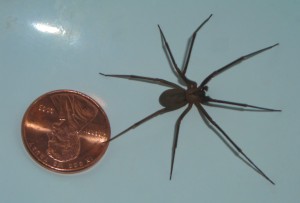The new (big) kid in town
Hello. I am Zoro. Fear me—but wait, no, do not fear me. I am not the monster I seem. I am invasive, but I am not … how do you say … of medical significance.
Presenting Zoropsis spinimana, a newcomer. A big, impressive newcomer. I happen to live in a part of California where this Mediterranean import has established itself. Lucky me, you say? Well, yes. It’s a big, handsome spider, slow-moving and easy to catch, and someday I’ll figure out exactly what it’s finding to eat in my walls and ceilings and crawlspaces that can satisfy its clearly big appetite. In the meantime, whenever I see daring Zoro, scourge of the arachnophobe, poised high up on the wall, it’s like Halloween every day! Boo!
Zoro, as I like to call it, has been dubbed the Bay Area’s Most Wanted Spider. Sort of like the World’s Most Interesting Man, which must be why I mentally shifted into that Puss in Boots accent. Stay hungry, my frien’. At the California Academy of Sciences in San Francisco, which dubbed it “most wanted” in a bit of savvy publicity, they’ve been tracking the spread of Zoropsis since the hefty house spider was first spotted around here. It has a gorgeous website there, complete with photos, videos, a map, instructions for reporting a new location, even tips for mailing in a spider—dead or alive—for inspection. The downloadable data sheet says, “Body size is the first thing you will notice about this species.” Yes, yes you will. Two inches (legs included) doesn’t sound like much until your daughter sees it on the bathroom wall.
What’s odd on that Cal Academy site is a distribution map that shows a straight arrow going nonstop from the Mediterranean to what looks like Sunnyvale. How did that happen?
“Hiding inside a suitcase” is the site’s suggestion, but, of course, ha. That’s just a guess. Darrell Ubick is the Cal Academy spider expert who’s keeping an eye on Zoropsis and its travels since it showed up in these parts in 1992. Ubick identified the newcomer courtesy of a specimen sent him by a cherished “spider lady,” the late naturalist Marjorie Moody, who worked for the state agriculture department.
However Zoropsis got here, it’s in no hurry. The spider has been seen a few times as far north as Marin County, Ubick says, but most of the reports still come from here in the Santa Clara Valley. In general, globalization accounts for a lot of species transfer; more people and goods and luggage crossing borders, more numb Central American spiders huddled in bananas in British shopping carts. But the Mediterranean region isn’t exactly Mali, is it? Ships and then planes from Europe and north Africa have been docking in the Bay Area for a very long time now. Zoro must have a story to tell about its covert crossing of the border, but we may never know it.
Some spiders seem to trigger the imagination. This one is dashing Zoro to me. Now, French people who post macro pix of this spider get a little frisson by pointing out not the Mark of Zorro but “le masque de Nosfératu.” The supposed mask is a pattern of black on white on the cephalothorax that suggests a vampire face with black eyes and pointy ears. Can you see it? How French are you? I’ve tried really hard to see Nosferatu but alors, I cannot.
Heck with romance, I think Zoropsis looks like a guy in a garish brown herringbone suit. He’s built like a wolf spider who’s put on a few, but with proportionately smaller eyes. He has that interesting dark pattern on the upper side of the abdomen; that helps to identify him. He roams, like the wolf spider. Willy Loman, schlepping his big opisthosoma around the countryside, hunting for the big sale. What I’ve noticed from briefly keeping Zoropsis specimens is that they try to conceal themselves in a container by climbing to the top and then streamlining their legs, four forward and four aft. It’s kind of endearing, and it makes them look not so big. They also seem to be good-natured, although tickling one’s foreleg with a bit of straw might make it pause and draw back the leg in that melodramatic “Wha! What means this?” gesture that thoughtful spiders (and movie vampires) make. Other times it seems like a golden retriever compared to a wolf, by which I mean the wolf spider Hogna carolinensis. I’ve kept a few of those, too. They’re athletic and fast, big shiny button eyes, dove-gray tracksuit, and the way they dash about and pounce on crickets is a dramatic contrast to phlegmatic Zoro. But Zoropsis, even if flair-impaired in reality, must be doing something right. The distribution map of the greater Bay Area shows a healthy scattering of red dots. Zoro was here!



